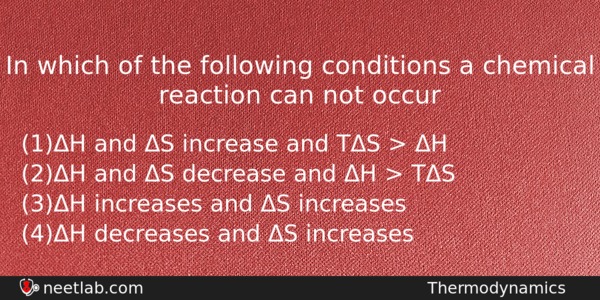| ⇦ | 
| ⇨ |
In which of the following conditions a chemical reaction can not occur
Options
(a) ΔH and ΔS increase and TΔS > ΔH
(b) ΔH and ΔS decrease and ΔH > TΔS
(c) ΔH increases and ΔS increases
(d) ΔH decreases and ΔS increases
Correct Answer:
ΔH increases and ΔS increases
Explanation:
(i)When ΔH and ΔS increase, then , if TΔS > ΔH the reaction is spontaneous.
Therefore ΔG = ΔH – TΔS = -ve.
(ii)When ΔH and ΔS decrease,then if ΔH > TΔS. This makes ΔG is -ve and process is spontaneous.
(iii) If , ΔH increases and ΔS decreases, then ΔG is +ve and process is non-spontaneous.
(iv) If ΔH decrease and ΔS increases, then ΔG is -ve and process is spontaneous.
Related Questions: - Oxidation number of Fe in Fe₃O₄ is
- If a 0.00001 M solution of HCl is diluted thousand folds the pH of the resulting
- One of the following metals is obtained by leaching its ore with
- In the reaction with HCl, an alkene reacts in accordance with the Markovnikov’s
- Which of the following can not be hydrolysed into aldose and ketose
Topics: Thermodynamics
(179)
Subject: Chemistry
(2512)
Important MCQs Based on Medical Entrance Examinations To Improve Your NEET Score
- Oxidation number of Fe in Fe₃O₄ is
- If a 0.00001 M solution of HCl is diluted thousand folds the pH of the resulting
- One of the following metals is obtained by leaching its ore with
- In the reaction with HCl, an alkene reacts in accordance with the Markovnikov’s
- Which of the following can not be hydrolysed into aldose and ketose
Topics: Thermodynamics (179)
Subject: Chemistry (2512)
Important MCQs Based on Medical Entrance Examinations To Improve Your NEET Score
18000+ students are using NEETLab to improve their score. What about you?
Solve Previous Year MCQs, Mock Tests, Topicwise Practice Tests, Identify Weak Topics, Formula Flash cards and much more is available in NEETLab Android App to improve your NEET score.
Share this page with your friends

Leave a Reply